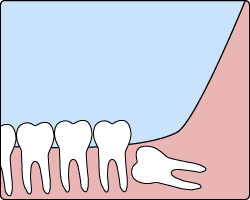Wisdom Teeth

The removal of wisdom teeth has become so commonplace that it is almost a rite of passage for young adults. Wisdom teeth are a type of molar that is found in the very back of your mouth. There are four wisdom teeth: upper left, upper right, lower left, and lower right. These teeth usually appear in the late teens or early twenties but may become impacted (fail to erupt) due to lack of room in the jaw or angle of entry. The most common type of impacted wisdom tooth is mesial, meaning that the tooth is angled forward toward the front of your mouth.
When a tooth is impacted, it may need to be removed. If it is not removed, you may develop gum tenderness, swelling, or even severe pain. Impacted wisdom teeth that are partially or fully erupted tend to be quite difficult to clean and are susceptible to tooth decay, recurring infections, and even gum disease.
Each patient's situation is unique, and your dentist will take x-rays and discuss your particular needs with you. If your dentist recommends removal of your wisdom teeth, it is best to have them removed sooner rather than later. As a general rule, wisdom teeth are removed in the late teens or early twenties because the bone surrounding the teeth is less dense and because there is a greater chance that the roots have not fully formed. These two factors can make extraction easier.
In order to remove a wisdom tooth, your dentist first needs access to it. To make this process most comfortable, your dentist will numb the area with a local anesthetic. Your dentist can even use additional medication to safely sedate you during the extraction if you are feeling nervous about the procedure. Because the impacted tooth is frequently under the gums and still encased in your jaw bone, your dentist will need to remove a portion of the covering bone to extract the tooth. To minimize the amount of bone that must be removed, your dentist will often "section" your wisdom tooth so that each section can be removed through a small opening in the bone.
Once the teeth have been extracted, the healing process begins. Healing time varies depending on the degree of difficulty related to the extraction. Your dentist will tell you what to expect and provide post operative instructions for an efficient healing.


